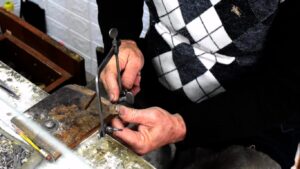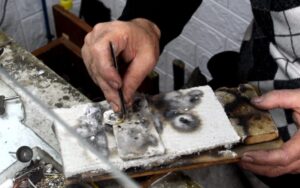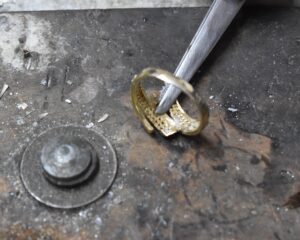The craft of kujunxhiu (the jeweler or goldsmith) is one of the old crafts that have stood up to the test of time quite well.
The jeweler deals with the manufacture and repair of precious gold or silver items. A characteristic of this craft is the space available, which is almost always a small corner.
A typical case to illustrate the jeweler’s work is sizing a gold ring larger.
As a first step, the jeweler cuts out a portion towards the bottom of the ring’s band and inserts it into the mullafa (ring mandrel) which is marked with grooved ring sizes for shaping and reshaping rings. Now, it is time to get the ring positioned to where and how much it will be stretched.
The next step is: The melted gold material is inserted on the level indicated by the mandrel. It is later grabbed with a pair of pliers and taken off the mandrel.
Still holding the band with pliers, it is pickled into nitric acid, brushing it on the part of the gemstones with a small feather. This process helps to protect this section from getting distorted during the soldering process.
The ring is then placed on a board over an asbestos paper to further go on with the soldering process.
Soldering is done with a buraxho (blowtorch – high-temperature lighter), which speeds up the process. Once this process is over, the ring’s band is left to cool down and then dipped in a vessel with boric acid. This serves to retain the color the element takes during soldering.
What comes next is smoothing the element, primarily with a rough file and then with a finer one. This process aids to avoid ill-fitting seams on the soldered area.
The ring passes then to the allokartisje process. This process serves to prevent scratches when the ring is worn, so it sits comfortably well.
Finally, the stretched ring is passed through a strip which is buffed with a green polishing compound. This process serves to provide a finish to the ring, maintain its structural integrity, and make seams invisible while it is next inserted back into the mullafa, tapped around by a rawhide mallet to ensure it is evenly round.




